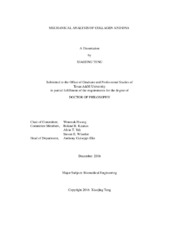| dc.description.abstract | It is known that mechanics plays a central role in many biological events. Tissue can
remodel and turnover to adapt to new mechanical environment, such as hypertension and
exercising. During the remodeling, hydrolysis of collagen is a key step. It is found that
extension will change the cleavage rate of both collagen monomers and fibrils. The specificity
of the collagen cleavage site is explained as the unique local mechanical environment
of the cleavage site. DNA is another important filament molecule, and its behavior is also
regulated by mechanics. The sequence-dependence of mechanical property has been observed,
and is related to the specific interaction between proteins and DNA.
On the pursuit of understanding the role of mechanics in those biological events as
well as connecting atomistic to mesoscale properties of biopolymers, we used molecular
dynamics (MD) simulation to study collagen and DNA. In collagen study, from the
local bending stiffness calculated around cleavage site, we found it is transitioned from
stiff to flexible across the cleavage site, which agrees with the classic model and can be
seen as the structural feature recognizable by MMPs. We showed that the α-chain registry
can determine the local conformation of collagen, and hence the cleavability of collagen.
The resistance of homotrimer form to hydrolysis is interpreted as the stabilization role of
arginines downstream to the cleavage site. Homotrimer form is found mainly in fetal tissue
and carcinomas, and related to osteogenesis imperfecta. This resistance mechanism can
help people to better understand its role in these processes. We further resolved controversial
findings in experiments regarding the relationship between extension and collagen
cleavage rate published the same year on the same journal. By mimicking the pulling
conditions in the experiments, we found it is their different ways of pulling that induces
different conformations, and therefore, different relationship of cleavage rate vs extension. This indicates the importance of mechanical environment on collagen.
In our DNA investigation, we further developed our triad method to make it being capable
for local isotropic mechanics study. We demonstrated the mechanical property is
mainly determined at the dinucleotide-level sequence. The sequence-dependent flexibility
can be applied to mechanical property prediction of any DNA sequence, as well as DNA
nanostructures construction. We found the overwhelmingly used helicoidal parameters
are not suitable for dynamic study, due to their degeneracy in describing conformational
changes. Based on our data, we built a coarse-grained model that can capture the mechanical
properties measured in experiments. This model bridges the atomistic dynamics
and mesoscale property of DNA. By using the obtained stiffness and equilibrium data, we
calculated energy of crystal structures of dsDNA-protein complexes without non-standard
bases and paring. The results provided quantitative insight into the DNA-protein interaction
dynamics. We further analyzed DNA methylation, a fundamental epigenetic modification
that generates profound impact on gene regulation. We showed methylation generally
will cause the immediate neighbor steps to be stiffer, whereas the methylated step itself
less affected in mechanics. This is mainly because the steric interaction between methyl
groups of methylated cytosine with other groups. We also demonstrated the hydration distribution
change upon methylation could play a role in the stiffness variation, as well as
affect the binding affinity to different proteins, since hydration force is key in molecular
interactions. The findings in this study display influence of methylation in high resolution,
and are potentially helpful to elucidate the mechanism of methylation in gene regulation.
Currently we are investigating interaction between kinesin-1 motor head and tubulin.
Its dimer or tetramer form can walk unidirectionally on microtubules (MTs), in an out-of phase
manner. The motion can be attributed to different binding affinity when pulled in
different directions and various nucleotide binding modes. We will simulate those different
conditions to understand the atomistic mechanism. | en |


